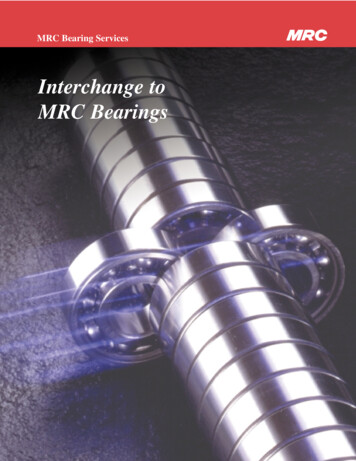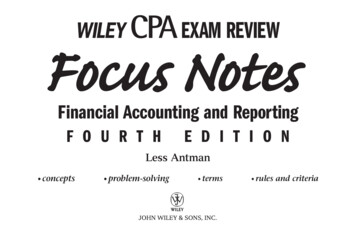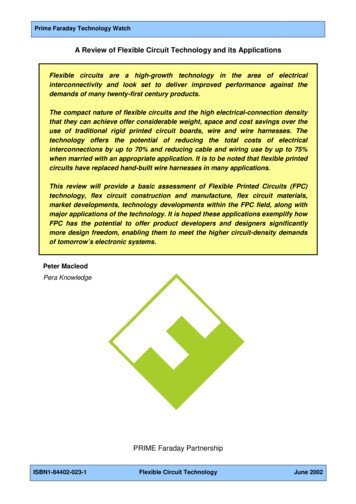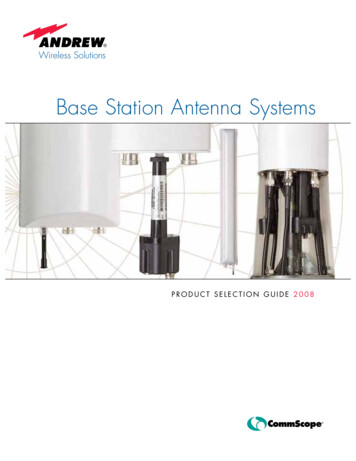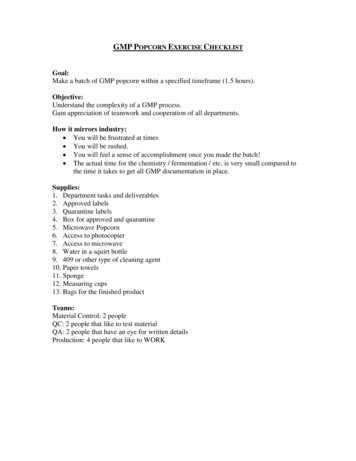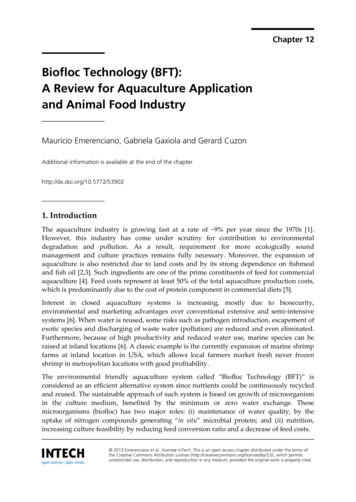
Transcription
Chapter 12Biofloc Technology (BFT):A Review for Aquaculture Applicationand Animal Food IndustryMaurício Emerenciano, Gabriela Gaxiola and Gerard CuzonAdditional information is available at the end of the chapterhttp://dx.doi.org/10.5772/539021. IntroductionThe aquaculture industry is growing fast at a rate of 9% per year since the 1970s [1].However, this industry has come under scrutiny for contribution to environmentaldegradation and pollution. As a result, requirement for more ecologically soundmanagement and culture practices remains fully necessary. Moreover, the expansion ofaquaculture is also restricted due to land costs and by its strong dependence on fishmealand fish oil [2,3]. Such ingredients are one of the prime constituents of feed for commercialaquaculture [4]. Feed costs represent at least 50% of the total aquaculture production costs,which is predominantly due to the cost of protein component in commercial diets [5].Interest in closed aquaculture systems is increasing, mostly due to biosecurity,environmental and marketing advantages over conventional extensive and semi-intensivesystems [6]. When water is reused, some risks such as pathogen introduction, escapement ofexotic species and discharging of waste water (pollution) are reduced and even eliminated.Furthermore, because of high productivity and reduced water use, marine species can beraised at inland locations [6]. A classic example is the currently expansion of marine shrimpfarms at inland location in USA, which allows local farmers market fresh never frozenshrimp in metropolitan locations with good profitability.The environmental friendly aquaculture system called “Biofloc Technology (BFT)” isconsidered as an efficient alternative system since nutrients could be continuously recycledand reused. The sustainable approach of such system is based on growth of microorganismin the culture medium, benefited by the minimum or zero water exchange. Thesemicroorganisms (biofloc) has two major roles: (i) maintenance of water quality, by theuptake of nitrogen compounds generating “in situ” microbial protein; and (ii) nutrition,increasing culture feasibility by reducing feed conversion ratio and a decrease of feed costs. 2013 Emerenciano et al., licensee InTech. This is an open access chapter distributed under the terms ofthe Creative Commons Attribution License (http://creativecommons.org/licenses/by/3.0), which permitsunrestricted use, distribution, and reproduction in any medium, provided the original work is properly cited.
302 Biomass Now – Cultivation and UtilizationAs a closed system, BFT has primordial advantage of minimizing the release of water intorivers, lakes and estuaries containing escaped animals, nutrients, organic matter andpathogens. Also, surrounding areas are benefitted by the “vertically growth” in terms ofproductivity, preventing coastal or inland area destruction, induced eutrophication andnatural resources losses. Drained water from ponds and tanks often contains relatively highconcentrations of nitrogen and phosphorous, limiting nutrients that induce algae growth,which may cause severe eutrophication and further anaerobic conditions in natural waterbodies. In BFT, minimum water discharge and reuse of water prevent environmentdegradation and convert such system in a real “environmentally friendly system” with a“green” approach. Minimum water exchange maintain the heat and fluctuation oftemperature is prevented [7], allowing growth of tropical species in cold areas.Currently, BFT has received alternate appellation such as ZEAH or Zero ExchangeAutotrophic Heterotrophic System [8-10], active-sludge or suspended bacterial-basedsystem [11], single-cell protein production system [12], suspended-growth systems [13] ormicrobial floc systems [14,15]. However, researches are trying to keep the term “BFT orBiofloc Technology” in order to establish a key reference, mainly after the book release“Biofloc Technology – A Practical Guide Book” in 2009 [16]. Moreover, BFT has been focus ofintensive research in nutrition field as a protein source in compounded feeds. Such source isproduced in a form of “biofloc meal”, mainly in bioreactors [17]. In addition, the fast spreadand the large number of BFT farms worldwide induced significant research effort ofprocesses involved in BFT production systems [14].The objective of this chapter is to review the application of Biofloc Technology (BFT) inaquaculture; and describes the utilization of biofloc biomass (also described in this chapteras “biofloc meal”) as an ingredient for compounded feeds. An addition goal is to helpstudents, researchers and industry to clarify the basic aspects of such technology, aiming toencourage further research.2. History of BFTAccording to [18], BFT was first developed in early 1970s at Ifremer-COP (French ResearchInstitute for Exploitation of the Sea, Oceanic Center of Pacific) with different penaeid speciesincluding Penaeus monodon, Fenneropenaeus merguiensis, Litopenaeus vannamei and L.stylirostris [19,20]. Such culture system was compared with an “external rumen”, but nowapplied for shrimp [21]. At the same period, Ralston Purina developed a system based onnitrifying bacteria while keeping shrimp in total darkness. In connection with Aquacop,such system was applied to L. stylirostris and L. vannamei both in Crystal River (USA) andTahiti, leding considerations on benefits of biofloc for shrimp culture [22]. In 1980, a Frenchscientific program ‘Ecotron’ was initiated by Ifremer to better understand such system.Several studies enabled a comprehensive approach of BFT and explained interrelationshipsbetween different compartments such as water and bacteria, as well as shrimp nutritionalphysiology. Also in 1980s and beginning of 1990s, Israel and USA (Waddell MaricultureCenter) started R&D in BFT with tilapia and white shrimp L. vannamei, respectively, in
Biofloc Technology (BFT): A Review for Aquaculture Application and Animal Food Industry 303which water limitation, environmental concerns and land costs were the main causativeagents that promoted such research (Fig. 1).Figure 1. Biofloc technology at Ifremer, Tahiti (A), Sopomer farm, Tahiti (B), Waddell MaricultureCenter (C) and Israel (D) (Photos A and B: Gerard Cuzon; C: courtesy of Wilson Wasielesky; and D:courtesy of Yoram Avnimelech)Regarding to commercial application of BFT, in 1988 Sopomer farm in Tahiti (FrenchPolynesia) using 1000m2 concrete tanks and limited water exchange achieved a world recordin production (20–25 ton/ha/year with two crops) [22, 23]. On the other hand, BelizeAquaculture farm or “BAL” (located at Belize, Central America), probably the most famouscase of BFT commercial application in the world, produced around 11-26 ton/ha/cycle using1.6 ha lined grow-out ponds. Much of know-how of running worldwide commercial scaleBFT shrimp ponds is derived from BAL experience. In small-scale BFT greenhouse-basedfarms, Marvesta farm (located at Maryland, USA), probably is the well-known successfulindoor BFT shrimp farm in USA, can produce around 45 ton of fresh never frozen shrimpper year using 570 m3 indoor race-ways [24]. Nowadays, BFT have being successfullyexpanded in large-scale shrimp farming in Asia, Latin and Central America, as well as insmall-scale greenhouses in USA, South Korea, Brazil, Italy, China and others (Fig 2). Inaddition, many research centers and universities are intensifying R&D in BFT, mostlyapplied to key fields such as grow-out management, nutrition, BFT applied to reproduction,microbial ecology, biotechnology and economics.
304 Biomass Now – Cultivation and UtilizationFigure 2. Biofloc technology commercial-scale at BAL (A) and Malaysia (B), and pilot-scale in Mexico(C and D) (Photos A, B and D: Maurício Emerenciano; and C: courtesy of Manuel Valenzuela)3. The role of microorganismsThe particulate organic matter and other organisms in the microbial food web have beenproposed as potential food sources for aquatic animals [25]. In BFT, microorganisms presenta key role in nutrition of cultured animals. The macroaggregates (biofloc) is a rich proteinlipid natural source available “in situ” 24 hours per day [14]. In the water column occurs acomplex interaction between organic matter, physical substrate and large range ofmicroorganisms such as phytoplankton, free and attached bacteria, aggregates of particulateorganic matter and grazers, such as rotifers, ciliates and flagellates protozoa and copepods[26] (Fig 3). This natural productivity play an important role recycling nutrients andmaintaining the water quality [27,28].The consumption of biofloc by shrimp or fish has demonstrated innumerous benefits suchas improvement of growth rate [10], decrease of FCR and associated costs in feed [9].Growth enhancement has been attributed to both bacterial and algae nutritionalcomponents, which up to 30% of conventional feeding ration can be lowered due to bioflocconsumption in shrimp [29]. In reference [9] was reported that more than 29% of daily foodconsumed for L. vannamei could be biofloc. In tilapia, in [30] was estimated that feedutilization is higher in BFT at a rate of 20% less than conventional water-exchange systems.
Biofloc Technology (BFT): A Review for Aquaculture Application and Animal Food Industry 305Also, consumption of macroaggregates can increase nitrogen retention from added feed by7-13% [31, 32]. In this context, BFT has driven opportunities to use alternative diets. Lowprotein feeds and feeds with alternative protein sources different than marine-basedproducts (i.e. fishmeal, squid meal, etc) have been successfully applied in BFT [28, 33-35],leading “green” market opportunities.Figure 3. Grazers often observed in BFT such as flagellates protozoa (A), ciliates protozoa (B),nematodes (C) and copepods (D) (10x magnification) (Source: Maurício Emerenciano)Regarding to maintenance of water quality, control of bacterial community over autotrophicmicroorganisms is achieved using a high carbon to nitrogen ratio (C:N) [30], whichnitrogenous by-products can be easily taken up by heterotrophic bacteria [36]. High carbonto nitrogen ratio is required to guarantee optimum heterotrophic bacteria growth [14, 37],using this energy for maintenance (respiration, feeding, movement, digestion, etc), but alsofor growth and to produce new cells. High carbon concentration in water could supersedethe carbon assimilatory capacity of algae, contributing to bacteria growth. Aerobicmicroorganisms are efficient in converting feed to new cell material (40-60% of conversionefficiency), rather than higher organisms that spend about 10-15% to rise in weight [16].Bacteria and other microorganisms act as very efficient “biochemical systems” to degradeand metabolize organic residues [36]. In other words, they recycle very efficiently nutrientsin a form of organic and inorganic matter (un-consumed and non-digested feed, metabolicresidues and carbon sources applied as fertilizers) into new microbial cells.
306 Biomass Now – Cultivation and UtilizationThe carbon sources applied in BFT are often by-products derived from human and/oranimal food industry, preferentially local available. Cheap sources of carbohydrates such asmolasses, glycerol and plant meals (i.e. wheat, corn, rice, tapioca, etc) will be applied beforefry/post-larvae stocking and during grow-out phase, aiming to maintain a high C:N ratio( 15-20:1) and to control N compounds peaks. Also, a mix of plant meals can be pelletized(“green-pellet”) and applied into ponds [38]; or low protein diets containing high C:N ratiocan also be carried out [16,33]. The carbon source serves as a substrate for operating BFTsystems and production of microbial protein cells [36]. There are many considerations for itsselection such as costs, local availability, biodegradability and efficiency of bacteriaassimilation. In Table 1 is summarized some studies with different species and carbonsource applied in BFT system.Carbon sourceCulture specieReferenceAcetateMacrobrachium rosenbergii[39]Cassava mealPenaeus monodon[40]CelluloseTilapia[12]Corn flourHybrid bass and hybrid tilapia[41, 42]DextroseLitopenaeus vannamei[43]Glycerol andGlycerol BacillusM. rosenbergii[39]GlucoseM. rosenbergii[39]MolassesL. vannamei and P. monodon[9, 29, 44]Sorghum mealTilapia[12]TapiocaL. vannamei and M. rosenbergii[31, 45]Wheat flourTilapia (O. niloticus)[33]Wheat bran molassesFarfantepenaeus brasiensis, F. paulensis and F.duorarum[37, 46,47]StarchTilapia O. niloticus x O. aureus and tilapia(Mozambique)[7, 14]Table 1. Different carbon sources applied on BFT system (Source: adapted from [36])Not all species are candidates to BFT. Some characteristics seems to be necessary to achievea better growth performance such as resistance to high density, tolerance to intermediatelevels of dissolved oxygen ( 3-6 mg/L), settling solids in water ( 10 with a maximum of 15mL/L of “biofloc volume”, measured in Imhoff cones) [38] and N-compounds, presence offiltering apparatus (i.e. tilapia), omnivorous habits and/or digestive system adaptable tobetter assimilate the microbial particles.
Biofloc Technology (BFT): A Review for Aquaculture Application and Animal Food Industry 3074. Applications in aquaculture4.1. Nursery and grow-outNursery phase is defined as an intermediate step between hatchery-reared early postlarvaeand grow-out phase [48]. Such phase presents several benefits such as optimization of farmland, increase in survival and enhanced growth performance in grow-out ponds [49-51].BFT has been applied successfully in nursery phase in different shrimp species such as L.vannamei [44, 48], P. monodon [51], F. paulensis [15, 46], F. brasiliensis [37, 52] and F. setiferus[34]. The primary advantage observed is related to a better nutrition by continuousconsumption of biofloc, which might positively influence grow-out performance a posteriori[53], but was not always the case [54]. In addition, optimization of farm facilities providedby the high stocking densities in BFT nursery phase seems to be an important advantage toachieve profitability in small farms, mainly in cold regions or when farmers are operatingindoor facilities.In [46] was observed that presence of bioflocs resulted in increases of 50% in weight andalmost 80% in final biomass in F. paulensis early postlarval stage when compared toconventional clear-water system. This trend was observed even when postlarvae were notfed with a commercial feed (biofloc without commercial feed). In L. vannamei nursery in BFTconditions, references [48] and [55] reported survival rates ranging from 55.9% to 100% and97% and 100%, respectively. In [51] was demonstrated that the addition of substrates in BFTsystems increased growth and further enhanced production, while also contributing to morefavorable water quality conditions. According to the same study, growth and survival was notaffected by stocking density (2500 vs 5000 PL/m2), therefore greater production outputs wereachieved at the higher density. Furthermore, in [37] was found that F. brasiliensis postlarvaegrow similarly with or without pelletized feed in biofloc conditions during 30-d of nurseryphase, which was 40% more than conventional clear-water continuous exchange system.In grow-out, BFT has been also shown nutritional and zootechnical benefits. In [9] wasestimated that more than 29% of the daily food intake of L. vannamei consisted of microbialflocs, decreasing FCR and reducing costs in feed. The reference [10] showed that juveniles ofL. vannamei fed with 35% CP pelletized feed grew significantly better in biofloc conditions ascompared to clear-water conditions. In [28] was showed that controlling the concentration ofparticles in super-intensive shrimp culture systems can significantly improve shrimpproduction and water quality. Also, the same authors demonstrated that environmentallyfriendly plant-based diet can produce results comparable to a fish-based feed in BFTconditions. In [56] was evaluated the stocking density in a 120d of L. vannamei BFT culture,reporting consistent survival of 92, 81 and 75% with 150, 300 and 450 shrimp/m2,respectively. Moreover, the study [57] performed in a heterotrophic-based conditiondetected no significant difference in FCR when feeding L. vannamei 30% and 45% CP dietsand 39% and 43% CP diets, respectively. With these results in mind, floc biomass mightprovide a complete source of cellular nutrition as well as various bioactive compounds evenat high density. It is not known exactly how microbial flocs enhance growth. Growth mightbe enhanced by continuous consumption of “native protein”, protein source without
308 Biomass Now – Cultivation and Utilizationprevious treatment [18], which could possess a “growth factor” similar to the oneinvestigated in squid [58]. Is well known that protein, peptides and aminoacids participatefully in synthesis of new membranes, somatic growth and immune function and biofloc canpotentially provide such ingredients.For fish and other species, BFT also has been demonstrated encouraged results. IntensiveBFT Oreochromis niloticus tilapia culture could produce an equivalent of 155 ton/ha/crop [11].Besides high yields, decrease of FCR and decreased of protein content in diets have alsobeen observed. In [30] was estimated that feed utilization by tilapia is higher in BFT with aration 20% less than conventional water exchange system. Studying the effect of BFT injuveniles tilapia, the reference [33] showed no difference in fish growth/production between35% and 24% CP fed tanks under BFT, but both were higher than clear-water controlwithout biofloc with 35% CP. Moreover, in [7] was investigated the effectiveness of BFT formaintaining good water quality in over-wintering ponds for tilapia. The authors concludedthat BFT emerge as an alternative to overcome over-wintering problems, particularly massmortality of fish due to low temperatures. In the study [14] was observed that bioflocconsumed by fish (tilapia) may represent a very significant feed source, constituting about50% of the regular feed ration of fish (assuming daily feeding of 2% body weight).In M. rosenbergii larviculture was evaluated the effect of different carbon sources in a BFTculture conditions [39]. The authors found that using glucose or a combination of glycerolplus Bacillus as a carbon source in bioreactors led to higher biofloc protein content, higher n6 fatty acids, which resulted in improved survival rates. In a study with a Brazilian endemictropical fish species tambaqui (Colossoma macropomum) was observed that BFT did notimprove fish growth/production as compared to clear-water conditions [59], although somewater quality problems in such study remained unsolved (i.e. turbidity and nitrite). Theauthors showed no differences in 44% CP fed tanks under BFT and clear-water conditions,as well as 28% CP BFT. Certainly further research is needed to clarify the effect of BFT inColossoma macropomum. On the other hand, Piaractus brachypomus or pirapitinga seems to bea candidate species to BFT [60].4.2. BreedingThe BFT has been successfully applied for grow-out, but little is known about bioflocbenefits on breeding. For example, in the shrimp industry with the global spread of viruses,the use of closed-life cycle broodstock appeared as a priority to guarantee biosecurity,avoiding vertical transmissions. Moreover, such industry places a considerable interest onpenaeid breeding program, often performed in closed facilities, controlling the productionplan through successive generations. These programs were frequently associated with largeanimals, disease resistance as well as the enhancement of reproductive performance. However,nutritional problems remain unresolved [61] and alternatives should be evaluated.As an alternative for continuous in situ nutrition during the whole life-cycle, breeders raisedin BFT limited or zero water exchange system are nutritional benefited by the naturalproductivity (biofloc) available 24 hours per day. Biofloc in a form of rich-lipid-protein
Biofloc Technology (BFT): A Review for Aquaculture Application and Animal Food Industry 309source could be utilized for first stages of broodstock’s gonads formation and ovarydevelopment. Furthermore, production of broodstock in BFT could be located in small areasclose to hatchery facilities, preventing spread of diseases caused by shrimp transportation.In conventional systems breeders used to be produced in large ponds at low density.However, risks associate with accumulation of organic matter, cyanobacteria blooms andfluctuations of some water quality parameters (such as temperature, DO, pH and Ncompounds) remains high and could affect the shrimp health in outdoor facilities. Once thesystem is stable (sufficient particulate microbiota biomass measured in Imhoff cones), BFTprovides stabilized parameters of water quality when performed in indoor facilities such asgreenhouses, guaranteeing shrimp health.According to studies performed with the blue shrimp L. stylirostris [18] and the pink shrimpF. duorarum broodstock [62], BFT could enhance spawning performance as compared to theconventional pond and tank-reared system, respectively (i.e. high number of eggs perspawn and high spawning activity; Fig 4). Such superior performance might be caused bybetter control of water quality parameters and continuous availability of food (biofloc) in aform of fatty acids protected against oxidation, vitamins, phospholipids and highly diverse“native protein”, rather than conventional systems which “young” breeders are oftenlimited to pelletized feed. These nutrients are required to early gonad formation in youngbreeders and subsequent ovary development. The continuous availability of nutrients couldpromote high nutrient storage in hepatopancreas, transferred to hemolymph and directed toovary, resulting in a better sexual tissue formation and reproduction activity [18].Regarding to shrimp broodstock management, one of the most important managementprocedures is related to control of solids and stocking density. High levels of solidsnegatively affect shrimp health, particularly with shrimp weight higher than 15g [47].Settling solids or “biofloc volume” should be managed below than 15mL/L (measured inImhoff cones) [38, 47]. Excess of particulate organic matter covered breeder’s gills and couldlimit oxygen exchange, might resulting in mortalities.Stocking density has to be carefully managed, mainly in sub-adult/adult phase (i.e. 15g).High density or high biomass will lead to an increase in organic matter, TSS levels and Ncompounds in tanks or in ponds [63]. Moreover, physical body damages are prevented atlow density, improving breeder’s health. For review, a suggested stocking density is welldescribed in [64].For fish, no literature is available regarding BFT and application in breeders. The same trendobserved in penaeid shrimp might be observed in fish. The continuous consumption ofdiverse microbiota (biofloc) should improve nutrients transfer, gonad formation andreproduction performance in fish. Lipid is a well-known nutrient that plays a key role inreproduction of aquatic species. In tilapia, breeders fed with crude palm oil based-feed (n-6fatty acid rich source) presented high concentration of acid arachidonic or “ARA” (C20:4 n6) in gonads, eggs and larvae of tilapia as compared to fish oil or linseed oil-based feeds [65].As a result, better reproductive performance was observed in terms of higher total numberof eggs per fish, larger gonad sizes, shorter latency period, inter spawning interval and
310 Biomass Now – Cultivation and Utilizationhigher spawning frequency. ARA is an essential fatty acid crucial in reproduction, acting ashormone precursor [66]. In the study [33] was found high ARA content in biofloc harvestedin tilapia culture freshwater tanks. Bioflocs in freshwater bioreactors contained high ARAcontent using glucose and glycerol as a carbon source [67]. These findings suggested thatbiofloc (according its nutritional profile, for review see section 5.0) might positivelyinfluence the reproductive performance in fish, supplying nutrients for gonad development,possibly also enhancing larval quality a posteriori. BFT in tilapia broodstock could be aneffective method to increase tilapia fry production and further research is need in this field.Figure 4. Spawning performance of F. duorarum (tank-reared vs biofloc) and L. stylirostris (pond-rearedvs biofloc) performed in 45 and 30 days after ablation, respectively. Mean weights in parenthesis (moredetails in [18] and [62]).
Biofloc Technology (BFT): A Review for Aquaculture Application and Animal Food Industry 3114.3. The “natural probiotic” effect of bioflocBiofloc can be a novel strategy for disease management in contrast to conventionalapproaches such as antibiotic, antifungal, probiotic and prebiotic application. The “naturalprobiotic” effect in BFT could act internally and/or externally against, i.e., to Vibrio sp. andectoparasites, respectively. This effect is promoted by large groups of microorganisms, butmainly bacteria that is considered the first trophic level in the system.Internally, bacteria and its synthesized compounds could act similar to organic acids andmight be effective bio-control agents, also given beneficial host’s microbial balance in thegut [68]. The regular addition of carbon in the water is known to select forpolyhydroxyalkanoates (PHA) accumulating bacteria and other groups of bacteria thatsynthesize PHA granules. The microbial storage product poly-ß-hydroxybutyrate (PHB), abiodegradable polymer belonging to the polyesters class, is only one compound of a wholefamily of polyhydroxyalkanoates. PHB is produced by a widely variety of microorganismssuch as Bacillus sp., Alcaligenes sp., Pseudomonas sp. from soluble organic carbon and is alsoinvolved in bacterial carbon metabolism and energy storage [68]. This polymer couldcomprise 80% of the bacteria’s cell dry matter and up to 16% on biofloc dry weight [69].Different carbon sources or structures of carbon substrate will result in varying types ofPHA [69].Such granules are synthesized under conditions of physiological and nutrient stress, i.e.,when an essential nutrient like nitrogen is limited in the presence of an excess carbon source[68]. When these polymers are degraded in the gut, they could have antibacterial activitysimilar to short chain fatty acids (SCFAs) or organic acids. The breakdown of PHA insidethe gastrointestinal tract can be carried out via chemical and enzymatic hydrolysis [70].Chemical hydrolysis can be carried out by treating the polymers with, i.e., NaOH, in whichcould significantly accelerate its digestibility [70]. On the other hand, enzyme hydrolysis isgenerally carried out by extracellular depolymerases activities which are widely distributedamong bacteria and fungi, acting as a preventive or curative protector against Vibrio sp.infections and stimulate growth and survival of shrimp and fish larvae [69].The working mechanism of PHAs with respect to their antibacterial activity is not wellunderstood [68]. As they could act similarly to SCFA, some studies speculated the workingmechanism by (i) reduction of pH, in which antibacterial activity increases with decreasingpH value [71]; (ii) inhibiting the growth of pathogenic bacteria by interference on cellmembrane structure and membrane permeability, as well as instability of internal protonsbalance, lowering ATP and depletion of cellular energy [72]; and (iii) down-regulatevirulence factor expression and positively influence the gut health of animals [73]. Furtherresearch is need to maximizing PHA content in bioflocs applied, i.e., for fish/shrimp feed,characterizing and analyzing their bio-control efficacy in different host-microbe systems[68].Externally, the working mechanism of biofloc microorganisms against pathogens seems tobe by competition of space, substrate and nutrients. Some essentials nutrients such as
312 Biomass Now – Cultivation and Utilizationnitrogen are required by both groups (i.e. heterotrophic bacteria vs Vibrio sp.) limiting theirgrowth. Inhibiting compounds excreted by BFT microorganisms, light intensity and type ofcarbon source also could reduce pathogens growth. Unfortunately, limited information isavailable on this field. In a study with fish fingerlings [74] was reported that tilapia (initialweight 0.98 0.1g) reared under BFT limited water-exchange condition (FLOC) presentedless ectoparasites in gills and ectoderm’s mucous as compared to conventional waterexchange system (CW) after 60 days (Fig 5).Figure 5. Number of total ectoparasites in gills and ectoderm’s mucous of fry tilapia reared under BFTlimited water-exchange condition (FLOC) and conventional water-exchange system (CW) after 60 days(more details in [74])4.4. AquaponicsAquaponics is a sustainable food production system that combines a traditional aquaculturewith hydroponics in a symbiotic environment. The water is efficiently recirculated andreused for maximum benefits through natural biological filtration and recirculation. Thewaste that is excreted by aquatic species or uneaten feed is naturally converted into nitrateand other beneficial nutrients in the water. Those nutrients are then absorbed by thevegetables and fruits in a “natural fertilization way”.Aquaculture species including fish, crayfish, freshwater prawns or shrimp are usuallyreared in tanks and the water directed into separated race-ways of hydroponics vegetables.A worldwide well-known aquaponics system was successfully developed by University ofVirgin Islands (Fig 6). Typical plants raised in aquaponics include lettuce, chard, tomato,fruits such as passion fruit, strawberry, water melon, etc.; and a large variety of spices. Sizeof aquaculture tanks varies according aquatic species/vegetables demand and usual shapesincludes round, square or rec
produced in a form of “biofloc meal”, mainly in bioreactors [17]. In addition, the fast spread and the large number of BFT farms worldwide induced significant research effort of processes involved in BFT production systems [14]. The objective of this chapter is
